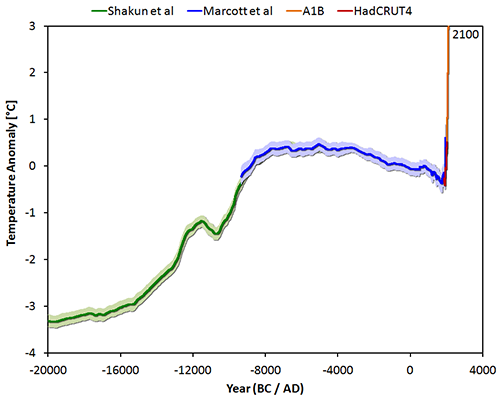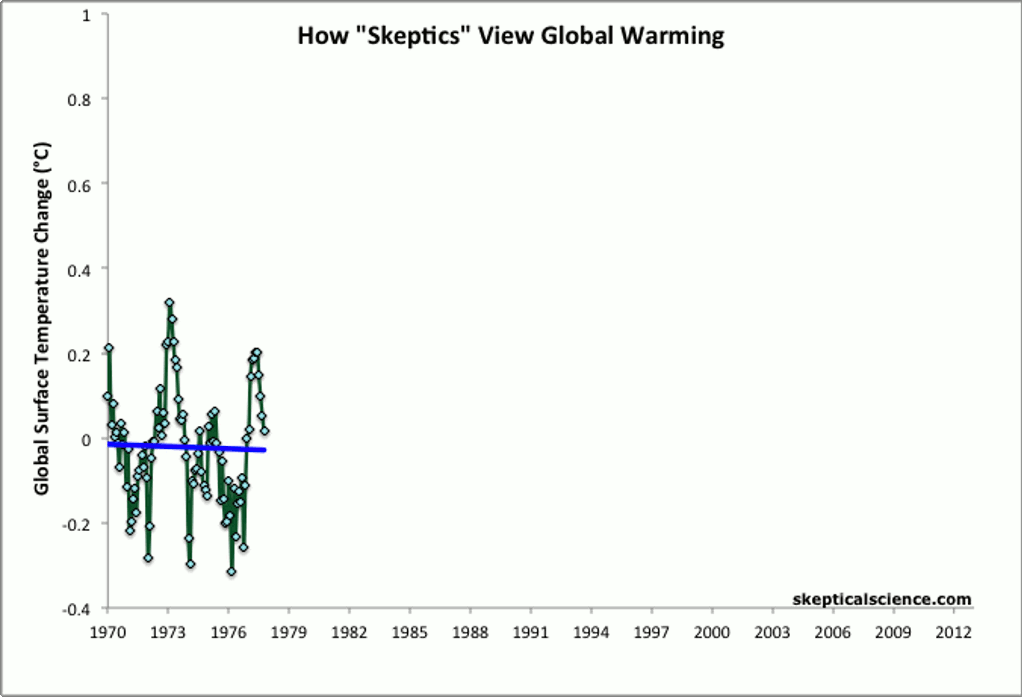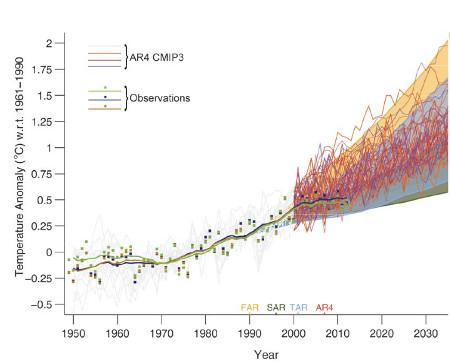2013 in Review: a Productive Year for Skeptical Science
Posted on 31 December 2013 by dana1981
2013 is coming to a close, and so we take a look back at some of the important climate-related events of our year.
Skeptical Science Makes Significant Scholarly Contributions
The Skeptical Science team published several high-impact papers this year, starting with the Cook et al. (2013) consensus paper, co-authored by nine Skeptical Science volunteers. The paper showed that there is a 97% consensus in the peer-reviewed climate science literature that humans are causing global warming. The paper has already been cited in a broad range of scholarly journals and made a big splash in the media, even being the subject of two presidential Tweets. It was also the 11th-most talked about academic paper in 2013.
Kevin Cowtan and Robert Way later published an important paper showing that much of the slowed global surface warming was an artifact of poor global temperature station coverage, mainly in the Arctic. Cowtan & Way (2013) has received extensive praise among scientists with relevant expertise due to the quality and importance of the paper. Most recently, Richard Alley discussed their results in testimony to the Pennsylvania House of Representatives.
Nuccitelli et al. (2013) also debunked a paper by Akasofu that tried to blame global warming on a magical 'natural recovery' from the Little Ice Age. As Nuccitelli et al. showed, climate changes must be caused by physical mechanisms, and Akasofu's argument lacked any physical basis.
Richardson (2013) demonstrated that the modern increase in atmospheric CO2 is entirely human-caused, debunking a paper by Humlum, Stordahl and Solheim that wrongly claimed otherwise.
John Cook's climate science and denial textbook with G. Thomas Farmer was published in January, and John was also invited to give three talks at the AGU fall meeting to discuss what his research tells us about effective climate communications.
The 'Pause' Myth Debunked Once and for All
Over the past year, the myth of the global warming 'pause' has become a favorite among climate contrarians. The argument has always been fundamentally flawed, because as The Escalator shows, it's based entirely on cherry picking short-term noise in the data.
Moreover, as Cowtan & Way (2013) demonstrated, even the short-term slowing of global surface temperatures was largely an artifact of poor Arctic temperature station coverage.
Additionally, by incorporating data from Nuccitelli et al. (2012), the Skeptical Science heat widget pointed out that during the time since global warming was supposed to have 'paused', the global climate accumulated over 2 billion Hiroshima atomic bomb detonations worth of heat.
Skeptical Science has now thus debunked the 'pause' myth from three different angles.
Important Climate Research in 2013
Several other climate papers this year helped to debunk the 'pause' myth and explain the short-term slowing of global surface warming. Kosaka & Xie (2013) showed that changes in the Pacific Ocean could account for most of the short-term global surface temperature changes. Along those lines, Watanabe et al. (2013) showed that ocean heat uptake has become more efficient over the past decade, which is consistent with the observations of Balmaseda et al. (2013), who found an unprecedented transfer of heat to the deep oceans over the past decade, consistent with the modeling in Meehl et al (2013).
Putting it all together, we have an increasingly clear picture that while the warming of global surface temperatures has slowed over the past decade, it has not slowed as much as previously thought. The slowed surface warming is due in large part to changes in ocean cycles, particularly in the Pacific Ocean, causing more efficient ocean heat uptake, thus leaving less heat to warm surface temperatures. External factors, like decreased solar and increased volcanic activity, have also played a role in the slowed surface warming, but internal variability due to ocean cycles appears to be the main culprit. In any case, as the 2013 IPCC Fifth Assessment Report showed, the observed global surface warming remains within the range of climate model projections.
IPCC AR5 Figure 1.4. Solid lines and squares represent measured average global surface temperature changes by NASA (blue), NOAA (yellow), and the UK Hadley Centre (green). The colored shading shows the projected range of surface warming in the IPCC First Assessment Report (FAR; yellow), Second (SAR; green), Third (TAR; blue), and Fourth (AR4; red).
Marcott et al. (2013) also showed that the warming we’ve witnessed in the last 100 years is unlike anything that happened in the previous 11,300 years, and that the warming yet to come in a business-as-usual scenario looks downright scary.

The temperature reconstruction of Shakun et al. (green – shifted manually by 0.25 degrees), of Marcott et al. (blue), combined with the instrumental period data from HadCRUT4 (red) and the model average of IPCC projections for the A1B scenario up to 2100 (orange). Created by Jos Hagelaars.
A brand new study by Sherwood et al. (2013) tackles the question of how cloud cover will change and interact with global warming as the climate continues to change. The cloud feedback question is one of the largest remaining uncertainties in future climate predictions, so this is an important new paper. Unfortunately it finds that clouds will act to amplify global warming, suggesting that the planet will warm at least 3°C in response to a doubling of atmospheric carbon dioxide, which also suggests at least 4°C global surface warming by 2100 if we continue with business as usual policies.
Mixed Bag of Climate Policies
With regards to those policies, 2013 was a bit of a mixed bag. Australia elected a majority government that has pledged to eliminate its carbon tax. In Canada, the government has paid service to climate change while muzzling its scientists and doing everything possible to increase its emissions through maximum development of the tar sands.
However, on a local level, British Columbia's revenue-neutral carbon tax remains highly popular and successful, and California implemented a similarly popular carbon cap and trade system in 2013. And the national news isn't all bad, as the US government has issued draft regulations on greenhouse gas emissions from new power plants, and is working on regulations for existing power plants. There are also encouraging signs that China is beginning to address its rapid emissions growth.
However, on an international level, 2013 passed with very little progress in terms of establishing a new international climate agreement. 2015 is the target date for new emissions reductions plans.
2013 Summary
Overall 2013 was a productive year in terms of reducing the consensus gap and debunking the 'pause' myth. Climate policies were a mixed bag, with some steps backwards and some steps forward. Climate media coverage was likewise a mixed bag, with continued false balance and inaccurate reporting from the politically conservative media, also seeping into the BBC. The New York Times eliminated its environment desk, but The Guardian stepped in to fill the gap with its new Environment Blogs.
2013 was a productive year for Skeptical Science, which also saw the number of followers on its Facebook page grow rapidly and surpass 16,000, and its Twitter page to over 8,500. A lot of interesting new climate research was published during the year, including a new IPCC synthesis report. However, progress toward solving the climate problem remained far too slow. Here's to 2014 being a more productive year for climate solutions.































 Arguments
Arguments
































Great summary Dana. To you and everyone else on the team, great work, everything you guys put out gets more and more impressive. The level of intellectual sophistication and creativity in the way it's communicated just keeps improving.
By the way can you add the link to Nuccitelli et al. (2012)? I don't remember which one that was.
Thanks Dawei!
Nuccitelli et al. (2012)
There goes another favourite meme of the denialisti, that clouds will cool the planet (not that I wish to appear to be celebrating bad news). Ironic that BAU will result in such a change in the environment that big business will become no more than a despised memory. 4°C is nothing to look forward to, but that's where we are tracking. Homo Stupidus stupidus.
Congratulations to SKS on their achievements in 2013. Amongst much else I have appreciated the weekly news summary from John Hartz.
I'm interested in any comments about the following. In this posting there's the following statement - "External factors, like decreased solar and increased volcanic activity, have also played a role in the slowed surface warming, but internal variability due to ocean cycles appears to be the main culprit."
However in John's recent weekly news (28 Dec) the 3rd article (Climate change 2013: Where we are now - not what you think) contained - "The new IPCC report tells us that half of warming (57%) that should have already occurred has been masked by aerosols mostly emitted since the turn of the century in rapidly developing Asian nations (yes, warming would double if cooling smog pollutants were suddenly cleaned up in Asia)."
BC @4 - I don't know where they get 57% from. The IPCC report did say the mythical 'pause' is due to about half changes in external forcings and about half due to internal variability. My sense was that they were just being very non-specific and saying 'about half and half' because they didn't have the confidence to be any more precise than that. Personally I think that recent research (including several studies discussed in the above post, published after the IPCC AR5 cutoff date) make a strong case that internal variability (ocean cycles) are responsible for more of the slowdown in surface warming than changes in external forcings, but there's not a consensus about that yet.
Doug@3,
A new study (via Mike Mann's facebook) :
Climate: Cloud Mixing Means Extra Global Warming
is another nail into the coffin of "Iris hypothesis" by Dick Lindzen. Clouds, if anything, may amplify the forcing of GHG such as H20. And that's consistent with generally higher CS value deduced from paleo record rather than from direct observations. How much more evidence is needed before we finally put to bed Lindzen's sticky idea? Incredible.
Dana
thanks for this. And to Chriskoz for the link. There is also a Guardian article on Sherwood's paper on P9 of today's paper (1/1/14) Here is a link to the online version
http://www.theguardian.com/environment/2013/dec/31/planet-will-warm-4c-2100-climate
[JH] Link activated.
We've got a couple posts coming up on Sherwood's paper.
"We've got a couple posts coming up on Sherwood's paper."
When you do, you might want to include this brief, clear explanatory video featuring Sherwood himself:
[PS] Fixed link
Thanks for an excellent, interesting summary, Dana! Would it be possible to provide a higher-resolution version of the last figure (by Jos Hagelaars). I have difficulty telling where the red ends and the orange begins.
I am looking for a reference I can use regarding "increased volcanic activity," as one of the reasons why there has been some apparent cooling, as I am writing a chapter on 'climate change denial' as unethical behaviour for a book on ethics (to be called "Engineering ethics: International and environmental stability"). I am sure I have read somewhere that "volcanic activity has been approximately twice as strong in the years 2008 to 2011 than between 1999 and 2002." I thought it was in WGIAR5 SPM, but I cannot find it there. I also keep reading that the Pinatubo eruption was stronger than anything later. I am aware of papers explaining other reasons why surface warming has been less than expected. By the way, an multi-disciplinary online course on "Climate change: challenges and solutions" by scientists from Exeter University and the Met Office starts next week. I just hope it helps to change the indifferent and hostile reaction towards the subject which has been so common after Climategate,
Bienh
Bienh - I don't know where you might have read that; GISS lists forcings up through 2012, and there is no such increase in stratospheric aerosols that might be coming from volcanic activity.
[Source]
Bienh,
I think the reference you want is Solomen et al a popular science description is here. They describe variable stratospheric aerosol reducing the temperature about 0.05 C in the past decade. I did not understand how they separated anthropogenic and natural aerosols. Google is your friend.
They claim that aerosols will significantly affect temperatures in the future and models will be inaccurate if this is not considered (seems obvious enough to me).